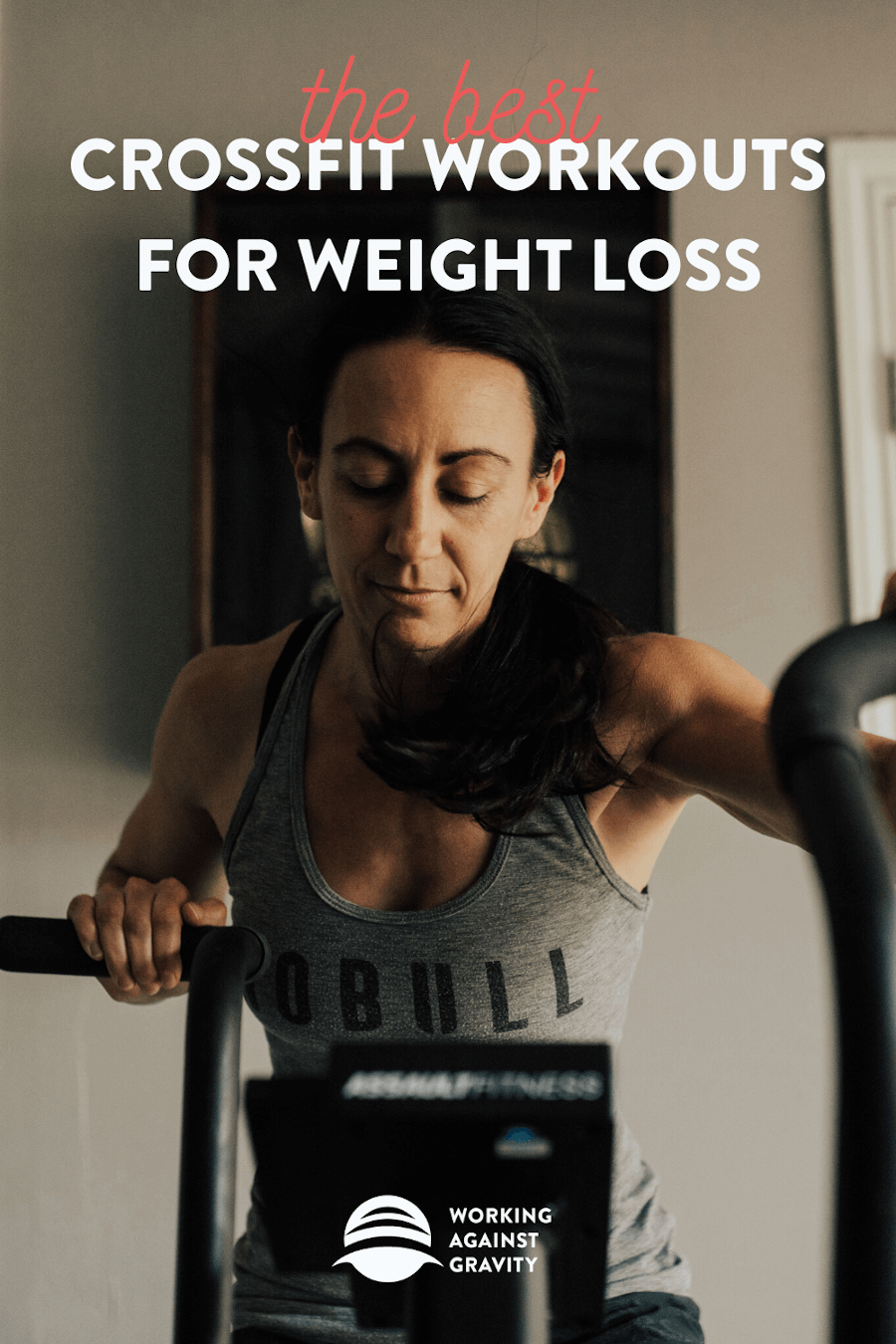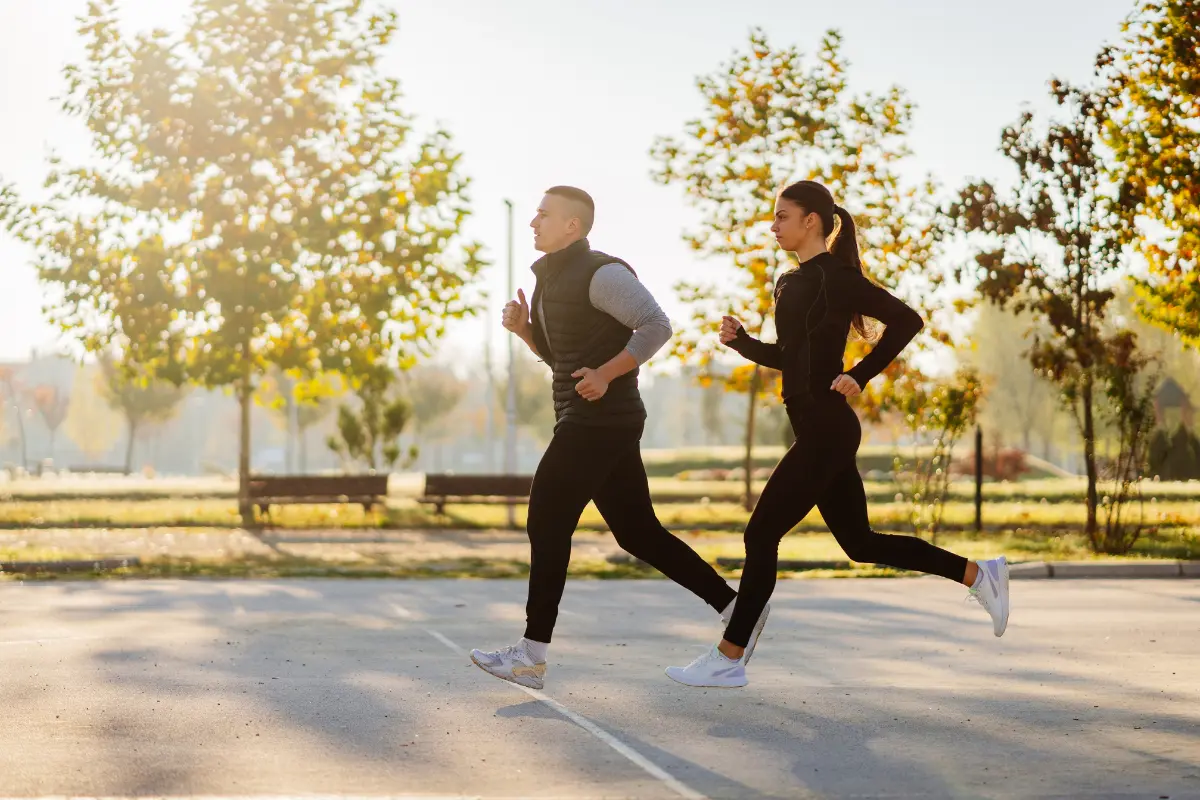
Many people get into CrossFit because of their weight loss goals. This begs the question, what are the best CrossFit workouts for weight loss? Are some workout styles more effective in fat burning than others? What about strength building and losing fat at the same time?

(Want to save these for later? Pin it!)
Does CrossFit Burn Fat?
CrossFit is killer for fat burning. Why?
Most CrossFit workouts are created in a HIIT (high-intensity interval training) style. A HIIT workout typically consists of shorter bursts of intensity with alternating rest periods [1]. To get the “best” benefits from HIIT, you need to push as hard as you can during your working sets, rest, then get back at it.
Advertisement
HIIT workouts can last anywhere from 7-30 minutes and provide a longer calorie burn period post-workout than many steady-state cardio workouts [2].
Because HIIT workouts typically take less time to complete and give you a lot of calorie-burning bang for your buck (while supporting muscle along the way), CrossFit workouts have become a favorite among people wanting to burn fat, gain muscle or do both at the same time.
Fat Burning Benefits of CrossFit
Due to their high intensity, HIIT workouts have been shown to increase metabolic rate after exercise at higher rates than other training styles [3,4]. This increase in metabolism (sometimes for hours after your workout has finished) means you’re likely to burn more calories once your training has finished. Burning calories at rest… sounds like the dream, right?
CrossFit workouts also include resistance training whether it is completed with a barbell, dumbbell, kettlebell, odd object, or your bodyweight. This addition of higher rep weightlifting can help build lean muscle which may improve metabolic rate long-term [5].
Although intentional weight training still takes the cake when the main goal is muscle building, CrossFit workouts can still help you lose weight and put on muscle - especially if you're newer to the weight training game [6].
Advertisement
HIIT and lower intensity steady state cardio have their merits and when applied properly to a structured training program, can both be effective. Lower intensity cardio can help increase NEAT, increase recovery between higher intensity training sessions and has mood-boosting hormonal benefits as well [7].
But, it's easy to understand why HIIT training is popular when the fat-burning effects are one of the many benefits you receive.
CrossFit Workouts for Weight Loss
So what CrossFit workouts are best for weight loss and give you the most bang for your buck?
Most CrossFit classes include a lifting session prior to a metcon (metabolic conditioning - aka; cardio). This combination of taxing a large group of muscles under heavy load, followed by a series of high-intensity, functional movements across broad time domains is what gives you the ultimate calorie burn.
So, with that said, here we go:
Advertisement
Fat Burning CrossFit Workout #1: “Helen”
3 ROUNDS:
400m Run
21 Kettlebell Swings
12 Pull-ups
A tried and true CrossFit workout with a 400-meter run, kettlebell swings and pull-ups, Helen is a terrific way to compliment a strength piece and really get your heart rate up.
Kettlebell swings are an ultimate single-implement style movement that can help you shed fat fast. Plus, kettlebells are a staple in most CrossFit gyms and are easy to buy and use at home making them super accessible.
Want to go a little more intense? DOUBLE IT!
Fat Burning CrossFit Workout #2: “Fight Gone Bad”
3 ROUNDS FOR TOTAL REPS:
1 min Wall Balls
1 min Sumo Deadlift High-Pulls
1 min Box Jumps
1 min Push Press
1 min Row
1 min rest
Advertisement
This workout was designed for BJ Penn, a UFC fighter, back in the early days of CrossFit and it remains a staple in most gyms today.
What is it? Three rounds, one-minute per exercise, with one-minute rest between rounds of wall balls, sumo deadlift high-pulls, box jumps, push presses, and a row on a rowing machine.
This is one of my favorites since you go for MAXIMUM reps within that one-minute time span and then get to rest. This is precisely the kind of pacing and conditioning that helps burn fat and it is exactly what a fighter would do (hence the name). If you haven't done this one, give it a shot.
Fat Burning CrossFit Workout #3: “MURPH”
FOR TIME:
1-mile run
100 pullups
200 pushups
300 air squats
1-mile run
Aside from “Fran”, this is likely the most well-known CrossFit workout in the world. It's incredibly challenging and this long-time domain will challenge your mind and body.
Advertisement
When it comes to calorie burn, longer metcons will be your ticket to shedding fat a little faster than doing only sprint/shorter style workouts as long as total volume and recovery are taken into account.
Remember, different workout times, movements and intensities have their place - your program needs a balance. Murph is a workout that can be done multiple times a year if you wish to do it, but I would not recommend it on a weekly basis (unless you are an absolute savage).
Fat Burning CrossFit Workout #4: “Tabata”
8 ROUNDS:
20 sec Work
10 sec Rest
Tabata workouts are technically HIIT but include shorter work-to-rest periods. Where HIIT can sometimes look like 2-3 minute spurts of work time, Tabata workouts are typically done in 8 rounds of 20-second work periods with 10 seconds of rest in between.
A Tabata set lasts four minutes and you can decide what movement to “work” through based on your training goals, what you have access to, and what you’re in the mood for. From there, you can build a few sets onto each other to design workouts of many lengths.
Advertisement
Here is a Tabata workout example:
8 ROUNDS:
20 sec Burpees
10 sec Rest
8 ROUNDS:
20 sec Push-Ups
10 sec Rest
8 ROUNDS:
20 sec Sit-Ups
10 sec Rest
Tabata workouts are great for travel or when you’re crunched for time since they provide a framework you can adjust based on your needs.
CrossFit Nutrition and Weight Loss
These are only a few amongst HUNDREDS of CrossFit workouts that will help you burn fat and are best accompanied by proper diet and nutrition.
Advertisement
To get the most optimal results doing CrossFit and CrossFit-style training, diet is an important lever you can pull to enhance your performance and body composition. These workouts WORK, as long as your diet works as well.
Nutrition timing, food quality and recovery nutrition all play into getting the most out of your workouts. Our experienced WAG Nutrition coaches have years of practice under their belts helping members drop fat while feeling strong in the gym!
References:
- Alansare, A., Alford, K., Lee, S., Church, T., & Jung, H. (2018). The effects of high-intensity interval training vs. moderate-intensity continuous training on heart rate variability in physically inactive adults. Int J Envrion Res Public Health, 15(7), 1508. doi: 10.3390/ijerph15071508
- Falcone, P., Tai, C., Carson, L., Joy, J., Mosman, M., McCann, T., Crona, K., Kim, M., & Moon, J. (2015). Caloric expenditure of aerobic, resistance, or combined high-intensity interval training using hydraulic resistance system in healthy men. J Strength Cond Res, 29(3), 779-85. doi: 10.1519/JSC.0000000000000661
- Wingfield, H., Smith-Ryan, A., Melvin, M., Roelofs, E., Trexler, E., Hackney, A., Weaver, M., & Ryan, E. (2015). The acute effect of exercise modality and nutrition manipulations on post-exercise resting energy expenditure and respiratory exchange ratio in women: a randomized trial. Sports Med Open, 1(1), 11. doi: 10.1186/s40798-015-0010-3
- Schulbert, M., Palumbo, E., Seay, R., Spain, K., & Clarke, H. (2017). Energy compensation after print- and high-intensity interval training. PLoS ONE, 12(12). https://doi.org/10.1371/journal.pone.0189590
- Martins, C., Kazakova, I., Ludviksen, M., Mehus, I., Wisloff, U., Kulseng, B., Morgan, L., & King, N. (2016). High-intensity interval training and isocaloric moderate-intensity continuous training result in similar improvements in body composition and fitness in obese individuals. Int J Sport Nutr Exerc Metab, 26(3), 197-204. doi: 10.1123/ijsnem.2015-0078
- Damas, F., Phillips, S., Vechin, F., & Ugrinowitsch, C. (2015). A review of resistance training-induced changes in skeletal muscle protein synthesis and their contribution to hypertrophy. Sports Med, 45(6), 801-7. doi: 10.1007/s40279-015-0320-0
- Crawford, E. (2011, Aug 8). Walking can help relieve stress. NDSU Extension and Research News. https://www.ag.ndsu.edu/news/newsreleases/2011/aug-8-2011/walking-can-help-relieve-stress/
Schedule a Free Intro Call
Working Against Gravity has led the macro tracking and health space for over a decade. Our team doesn’t just understand the science of nutrition—we’ve spent years mastering the art of tailoring it to fit your life. That means no cookie-cutter plans, just real strategies that have worked for over 30,000 people.
Schedule a free call with our team to learn how working with a 1-on-1 WAG coach will help you reach your goals.



